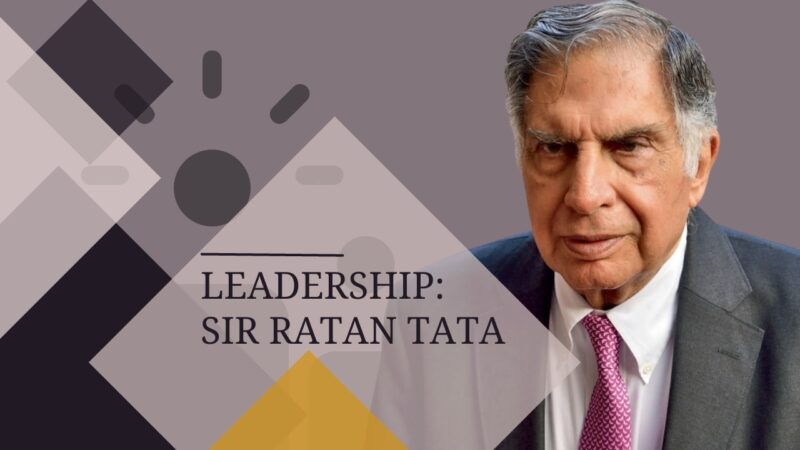Sir Ratan Tata, the venerable architect of the Tata Group, is a beacon of leadership whose influence transcends the confines of the boardroom. His leadership style, imbued with a unique blend of vision, humility, and risk-taking, has not only propelled the Tata Group to global prominence but also set a gold standard for corporate leadership.
“Leadership depends on the leader’s leadership style and their way of communicating ideas rather than the leader”, says Tata.
Sir Ratan Tata of the Tata Group is a more transformative leader. He established Tata Group as a global brand. He has served as an inspiration to executives inside his firm. At every level of the Tata Group, leaders are involved in decision-making. Ratan Tata is an example of a leader who is devoted to the Triple Bottom Line.
Ratan Naval Tata has also been honoured with the “PadamVibhushan” and “PadamBhushan” in 2008 and 2000, respectively, for his contributions to commerce and industry. In my perspective, he is the most notable Indian leader whose inner ideals and exterior deeds reflect an advanced higher degree of responsible leadership.
Ratan Tata’s leadership is characterized by a transformative approach that has seen the Tata Group evolve from a largely domestic entity to a global powerhouse. His vision for the Tata Group was not confined to the borders of India. Despite facing opposition, he insisted on global expansion, a move that has seen overseas income account for half of Tata’s total revenue. Under his stewardship, the Tata Group has acquired global brands such as Tetley, Jaguar Land Rover, and Taj Boston, further cementing its international presence.
Mr. Jamsetji Nusserwanji Tata has provided us with his inspiration, his ethics, values and selflessness which have provided dignity and livelihood to thousands of citizens. My best wishes go out to all the Tata group employees on the birth anniversary of our founder. pic.twitter.com/v8YXYluIZS
— Ratan N. Tata (@RNTata2000) March 3, 2022
Leadership is not always about developing the strategy and building a successful team but also about becoming a good human being. The five qualities below make Ratan Tata a great leader:
- He has a unique point of view: When he joined the company, it didn’t do much business outside of India. Even though many people opposed him, he insisted that the firm become worldwide. Overseas income now accounts for half of Tata’s total revenue. Tata purchased trademarks such as Tetley, Jaguar Land Rover, and Taj Boston under his leadership.
- He is well-known for his humility, as seen in several cases: He began his career as a blue-collar worker for Tata Steel, a testament to his belief in understanding the organization from the ground up. His humility is also evident in his response to the September 11, 2001, terrorist events, where he personally visited the families of the 80 affected employees. His approachability and attentiveness have endeared him to everyone who knows him.
- He is the best decision-maker: A famous quote of his is “I don’t believe in making the right decisions. I take decisions and then make them right.”
- He inspires others: Tata succeeds because its people and management uphold its ideals. Ratan Tata has ensured that the massive corporation adheres to Tata principles. The company’s aim is “to improve the lives of the communities we serve globally”.
- He likes to take risks: He has taken significant decisions, such as developing the Tata Nano and owning Europe’s second-largest steelmaker.
He persuaded Tata Tea to buy Tetley, Tata Motors to buy Jaguar Land Rover, and Tata Steel to buy Corus. All of this transformed Tata from a mostly Indian conglomerate into a worldwide corporation, with operations and sales in more than 100 countries accounting for more than 65 per cent of total revenue. He designed the Tata Nano automobile.
He is also available on instagram:
View this post on Instagram
He always follows his five principles to accomplish his goals:
- TVC: Trust, values, and commitment are important components of the Tata Group, and you should prioritize values and commitment over profits.
- Never stop learning: No matter how many degrees you have, you should never stop learning and never believe that something is impossible for you because the phrase itself says “I am possible.”
- Use your emotion for achievement: Never make a choice when you are angry or unhappy because “an angry mind is a narrow mind.” Instead, channel your anger into drive and achieve great success.
- Appreciate your team: No organization has ever achieved anything without teamwork and support. There is also a quote from Sir Ratan Tata.
- Believe in your decision: Accept the stones that others fling at you. And utilize them to erect a memorial”
Ratan Tata is a perfect example of a leader who is dedicated to the Triple Bottom Line. In my perspective, he is the most notable Indian leader whose inner ideals and exterior deeds reflect a more mature and responsible level of leadership.
He encourages others. Tata succeeds because its people and management uphold its ideals. Tata has ensured that the massive corporation adheres to Tata principles. The company aims to “improve the lives of the communities we serve globally.”
Ratan Tata’s leadership extends beyond the corporate world. He is one of India’s most philanthropic leaders, having donated over $50 million to various charities. He has also established the Tata Education and Development Trust, which provides scholarships to students from disadvantaged backgrounds. His commitment to social causes, such as improving education and healthcare in rural India, underscores his dedication to the Triple Bottom Line.
In conclusion, Sir Ratan Tata’s leadership is a testament to his vision, humility, decision-making prowess, ability to inspire, and propensity for risk-taking. His leadership style has not only transformed the Tata Group into a global conglomerate but also set a benchmark for responsible leadership.
His commitment to the Triple Bottom Line and his philanthropic endeavors further underscore his leadership’s holistic nature. Sir Ratan Tata’s leadership legacy is one of vision, virtue, and transformative impact, a legacy that will continue to inspire leaders for generations to come.
One great way for inspiring leaders is by reading a student essay on life and it’s obstacles. This short essay may help someone realize important life steps they’re missing.

